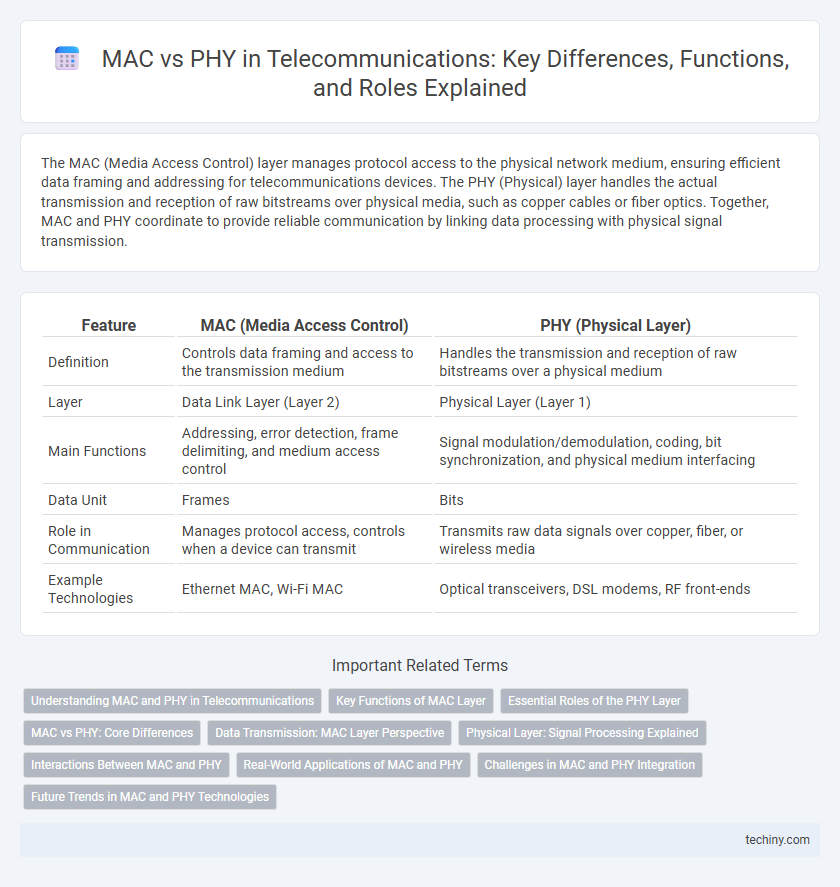The MAC (Media Access Control) layer manages protocol access to the physical network medium, ensuring efficient data framing and addressing for telecommunications devices. The PHY (Physical) layer handles the actual transmission and reception of raw bitstreams over physical media, such as copper cables or fiber optics. Together, MAC and PHY coordinate to provide reliable communication by linking data processing with physical signal transmission.
Table of Comparison
| Feature | MAC (Media Access Control) | PHY (Physical Layer) |
|---|---|---|
| Definition | Controls data framing and access to the transmission medium | Handles the transmission and reception of raw bitstreams over a physical medium |
| Layer | Data Link Layer (Layer 2) | Physical Layer (Layer 1) |
| Main Functions | Addressing, error detection, frame delimiting, and medium access control | Signal modulation/demodulation, coding, bit synchronization, and physical medium interfacing |
| Data Unit | Frames | Bits |
| Role in Communication | Manages protocol access, controls when a device can transmit | Transmits raw data signals over copper, fiber, or wireless media |
| Example Technologies | Ethernet MAC, Wi-Fi MAC | Optical transceivers, DSL modems, RF front-ends |
Understanding MAC and PHY in Telecommunications
The Medium Access Control (MAC) layer manages protocol access to the physical transmission medium, controlling data frame sequencing, error checking, and addressing in telecommunications networks. The Physical (PHY) layer, situated below the MAC, handles the actual transmission and reception of raw bitstreams over physical media like fiber optics, radio waves, or copper cables. Understanding the distinction between MAC and PHY is essential for optimizing network performance, as MAC ensures efficient channel access management, while PHY focuses on signal modulation, encoding, and transmission quality.
Key Functions of MAC Layer
The MAC (Media Access Control) layer regulates access to the shared communication medium, controlling frame delimitation, addressing, and error detection. It manages channel access protocols such as CSMA/CD or TDMA, ensuring efficient and collision-free data transmission. The MAC layer also handles frame sequencing, retransmission, and flow control to maintain data integrity and network performance.
Essential Roles of the PHY Layer
The PHY layer in telecommunications is responsible for the physical transmission of data over various media, such as copper cables, fiber optics, or wireless channels. It converts digital bits into electrical, optical, or radio signals, enabling effective communication across network devices. Critical functions include modulation, signal encoding, synchronization, and error detection to maintain data integrity and transmission efficiency.
MAC vs PHY: Core Differences
The Media Access Control (MAC) layer regulates access to the physical transmission medium by managing frame delimitation, addressing, and error checking, while the Physical (PHY) layer is responsible for the actual transmission and reception of raw bitstreams over physical cables or wireless channels. MAC interfaces with higher network layers to coordinate data frame delivery, whereas PHY deals with modulation, coding, and signal synchronization to ensure accurate bit transmission. Core differences include MAC's role in controlling channel access and frame formatting, contrasting with PHY's focus on electrical and optical signal processing.
Data Transmission: MAC Layer Perspective
The MAC layer controls data transmission by managing access to the physical medium, ensuring efficient frame synchronization, collision detection, and error correction. It segments and schedules data packets, optimizing bandwidth utilization and minimizing latency for wireless communication. The MAC layer's protocols directly influence throughput and network reliability in telecommunications systems.
Physical Layer: Signal Processing Explained
The Physical Layer (PHY) in telecommunications handles essential signal processing tasks such as modulation, encoding, and error correction to ensure accurate data transmission over a physical medium. PHY converts digital data into electrical, optical, or radio signals and manages synchronization, signal attenuation, and noise reduction for high-quality communication. Efficient PHY design directly impacts bandwidth utilization, latency, and the overall reliability of network connections.
Interactions Between MAC and PHY
The Media Access Control (MAC) layer manages protocol access to the physical transmission medium, coordinating frame delivery and error handling, while the Physical (PHY) layer handles the actual transmission and reception of raw bitstreams over the communication channel. Interactions between MAC and PHY layers involve synchronization of data framing, modulation, and signal processing to ensure efficient and reliable wireless communication. Effective collaboration between MAC and PHY optimizes bandwidth utilization, reduces latency, and maintains integrity in wireless networks such as LTE and Wi-Fi.
Real-World Applications of MAC and PHY
MAC (Medium Access Control) and PHY (Physical Layer) are crucial in telecommunications for managing data transmission and ensuring signal integrity. MAC controls access to the shared communication medium, optimizing bandwidth allocation in Wi-Fi networks and cellular systems like LTE and 5G. PHY handles the modulation, coding, and transmission of signals over physical channels, enabling reliable connectivity in fiber optics, DSL, and wireless technologies.
Challenges in MAC and PHY Integration
Integrating MAC (Media Access Control) and PHY (Physical Layer) in telecommunications presents challenges such as synchronization discrepancies, where timing mismatches can lead to data loss or corruption. The differing protocols and standards between MAC and PHY layers complicate seamless communication, requiring robust error correction and adaptive algorithms to ensure reliable data transfer. Power consumption and latency constraints further strain the integration, demanding efficient hardware design and optimized software coordination to maintain network performance.
Future Trends in MAC and PHY Technologies
Emerging MAC (Media Access Control) technologies prioritize low-latency and high-throughput protocols to enhance real-time data transmission in 5G and 6G networks. Advances in PHY (Physical Layer) technologies include the integration of AI-driven adaptive modulation and massive MIMO to improve spectral efficiency and signal robustness. Future trends emphasize cross-layer optimization between MAC and PHY layers to support ultra-reliable low-latency communications (URLLC) and massive machine-type communications (mMTC) in evolving IoT ecosystems.
MAC vs PHY Infographic

 techiny.com
techiny.com